The pea puffer (Carinotetraodon travancoricus) is a small species from rivers near the western coast of southern India.
This freshwater fish goes by many names, including the Malabar puffer and dwarf Indian puffer.
Aquarium keepers have long adored the pea puffer’s wonderfully interactive personality, likening them to puppies that follow and beg for treats.
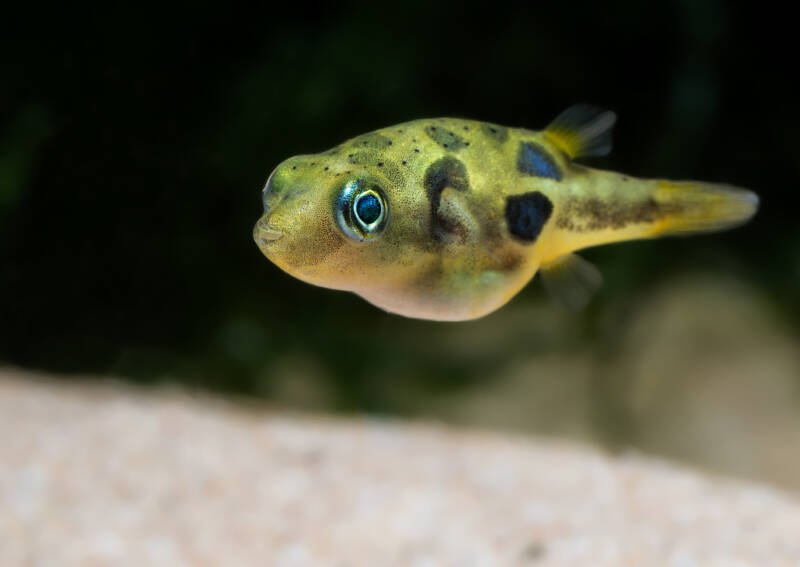
These fish have a lifespan of four years and reach an average length of 0.75 to 1.4 inches (1.9 – 3.6 cm), making them popular choices for nano aquariums.
But do not restrict these fish to single-species nanos. Pea puffers can thrive in community tanks when paired with the right species in the right setup.
Below, we touch on setup basics and list our favorite tank mates for this adorable fish.
In this article
Tank Setup
First, consider the size and layout of your aquarium.
A single puffer can live in a five-gallon tank, but if you want a group, plan on an additional three gallons of water for each fish.
When planning the layout, remember that pea puffers are territorial.
A well-designed tank will incorporate plants and decorations to break up the line of sight and minimize conflict.
Water Conditions
Next, ensure the water conditions suit all species. Because their body shape does not make for efficient swimming, pea puffers favor slow-moving waters.
Consider a sponge filter with an adjustable current. Install a heater to keep the water temperature consistent.
The following water conditions are ideal for the pea puffer, and tank mates’ needs should overlap with these:
- Temperature: 74 – 82F (23 – 28C)
- pH: 6.5 – 8.4
- Hardness: 4 – 10 dGH
- 0 ppm for ammonia, nitrate, nitrite.
Recommended Pea Puffer Tank Mates
Pea puffers can live as a single specimen or in a minimum group size of three. Keep a single male with two or more females, otherwise, males can squabble.
- Small, fast-swimming fish
- Schooling fish
- Fish that prefer the middle to upper layers of the water column.
Do not pair your pea puffer with the following:
- Larger, predatorial fish (your puffer will not be able to avoid them due to its poor swimming ability)
- Slow swimming fish
- Fish with long, flowing fins (your puffer will be tempted to take a bite)
- Freshwater snails.
The following are our favorite fish to place in a tank with pea puffers.
1. Zebra Danios (Danio rerio)
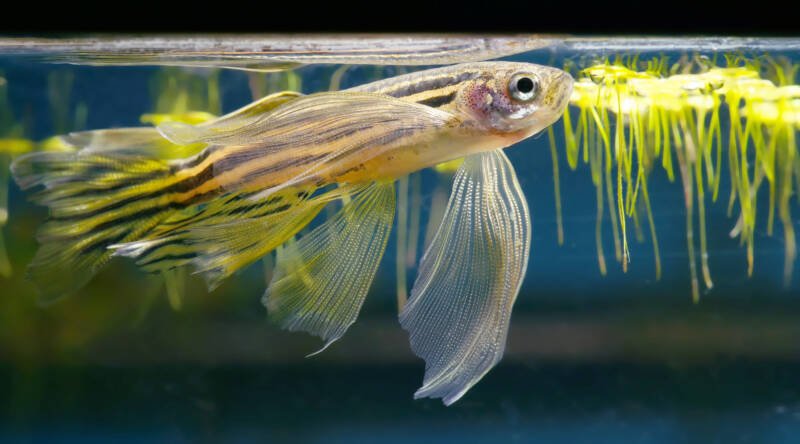
Minimum Tank Size: 10 gallons
Zebra danios are hardy, easy to care for, and playful.
Their small size and high activity level make them popular dither fish for community aquariums with aggressive species.
The danios’ relaxed nature brings a sense of calm to the tank, and they will keep well out of reach of your puffer.
Zebras have horizontal gold and blue/grey stripes that look amazing when the fish school.
They stay around two to 2.5 inches (5 – 6.4 cm) in length and the water parameters for these two species have ample overlap, making tank setup easy.
2. Otocinclus (genus)

Minimum Tank Size: 10 gallons
The humble, easy-going otocinclus spends hours grazing on algae and thereby boosting water quality.
They come in several color forms with different patterns gracing their two-inch-long (5 cm) bodies.
Their armored backside provides some protection from curious or aggressive fish.
Otos like their water on the cooler side but well within the pea puffer’s range.
Line your tank with a soft, sandy substrate to protect their undersides and include multiple hiding places.
Otocinclus are herbivores, which means they will not compete with your carnivorous pea puffer for food.
3. Pygmy and Panda Corys (Corydoras pygmaeus and Corydoras panda)
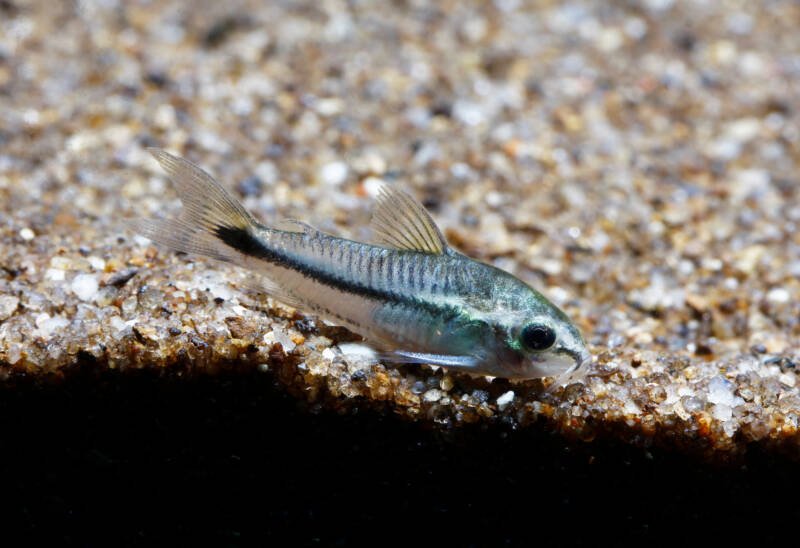
Minimum Tank Size: 10 gallons
These small bottom dwellers from the catfish family are extraordinarily peaceful and get along well in community tanks.
Pygmies barely reach an inch (2.5 cm) in length when fully grown, while pandas grow to around two inches (5 cm).

Water temperature and pH parameters overlap nicely; however, keep the hardness at the upper end of the pea puffer’s range and the lower end of the cory’s.
These omnivores eat algae but need a variety of sinking foods for optimum health.
Keep pandas in a group of three to five and pygmies in a group of eight.
4. Chili Rasboras (Boraras brigittae)
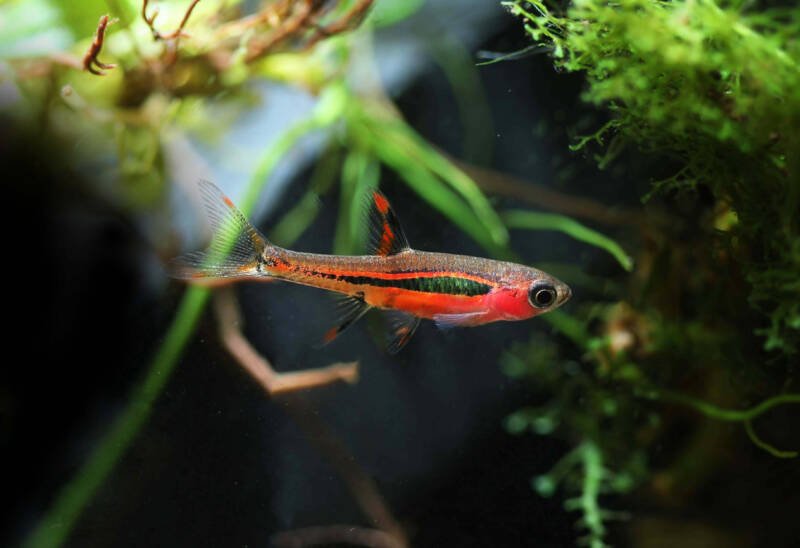
Minimum Tank Size: 5 gallons
Chili rasboras bring a pop of color to the tank as well as the calming effect of open water schooling.
They have a long lifespan of four to eight years and reach an adult length of only 0.7 inches (1.8 cm).
They tolerate a wide temperature range and prefer slightly more acidic water than the pea puffer.
Keep the pH close to neutral or just below to overlap. Chili rasboras prefer the upper half of the aquarium.
Introduce a group of six to 10 fully grown fish to your pea puffer tank as smaller ones may become prey.
5. Glowlight Tetras (Hemigrammus erythrozonus)
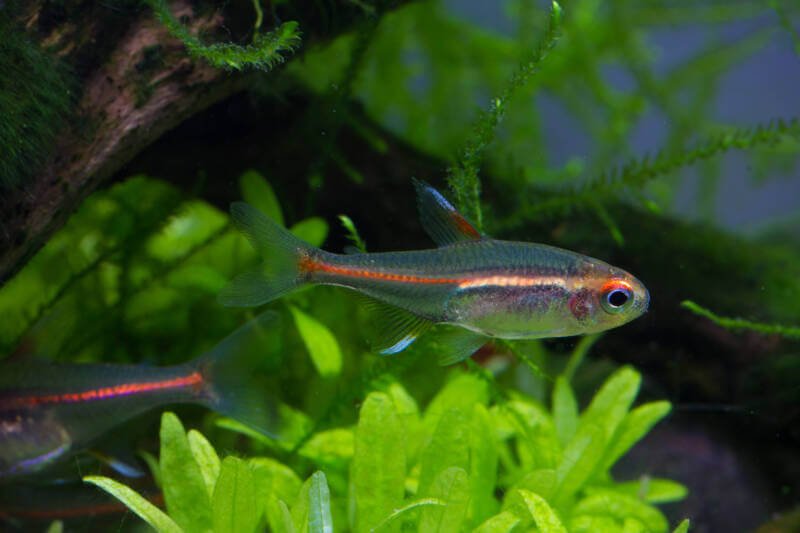
Minimum Tank Size: 10 gallons
With semi-transparent bodies and a vivid lateral line, the glowlight tetra’s 1.5-inch length (3.8 cm) makes a good puffer match size-wise.
They have a shorter lifespan than other tetras, maxing out at two to four years.
These fish prefer slightly acidic water and keeping the pH neutral will line up with your puffer’s needs.
They behave well when paired with slow-moving species and keep to the upper half of the aquarium.
A group of at least six is required to allow them to shoal; otherwise, they will hide most of the time.
6. Platies (genus Xiphophorus)

Minimum Tank Size: 10 gallons
Fast-swimming, a manageable 2.5-inch (6.4 cm) size, and a wide range of colors and patterns define the platy.
Aside from infighting among males, these highly social fish get along well with their tank mates.
Platies do not shoal but feel most comfortable if kept with a few others of their kind.
Water temperature and pH match well between the pea puffer and the platy; however, the platy loves very hard water.
Keeping the hardness near the upper end of the pea puffer’s range will allow overlap.
7. Guppies (Poecilia reticulata)

Minimum Tank Size: 10 gallons
Guppies are hardy, easy to care for and come in so many colors that you are certain to find one you like.
Keep this species in a group of all males or all females to avoid a tank full of fry from these active, live-bearing fish.
Guppies love the same warm and slightly alkaline waters as the pea puffer but prefer harder water.
Keep the hardness toward the upper end of the puffer’s range.
Take care when pairing male guppies with pea puffers as your puffer may be tempted to nip their fins.
8. Neon Tetras (Paracheirodon innesi)
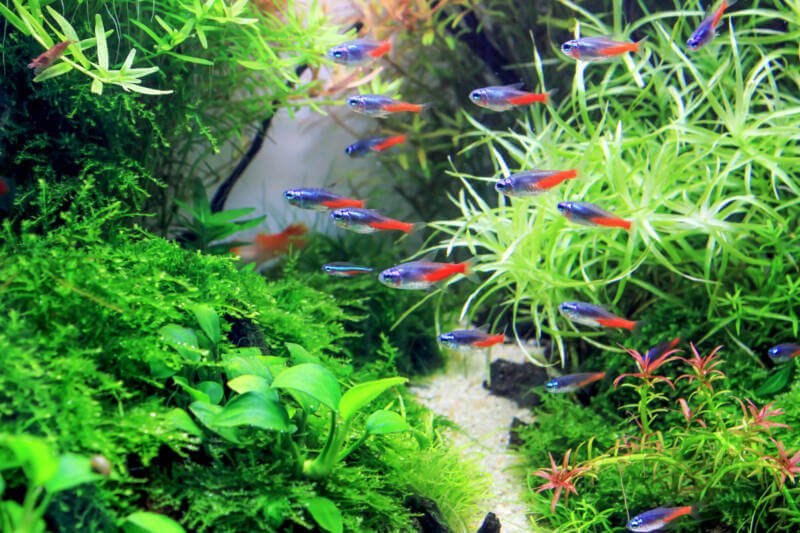
Minimum Tank Size: 10 gallons
Neon tetras are hardy, popular fish that reach an adult length of 1.5 inches (3.8 cm) and can live up to 10 years.
Their coloration and playful behavior bring activity to the middle level of the tank.
Keep these schooling fish in a group of 15 to be happy, occupied, and out of your pea puffer’s territory.
Water temperature and hardness need to match the pea puffer’s well.
Keep the pH near neutral to satisfy the needs of both species.
Maintain clean water conditions as these fish can contract neon tetra disease, which can impact other fish.
9. Blood-fin Tetras (Aphyocharax anisitsi)
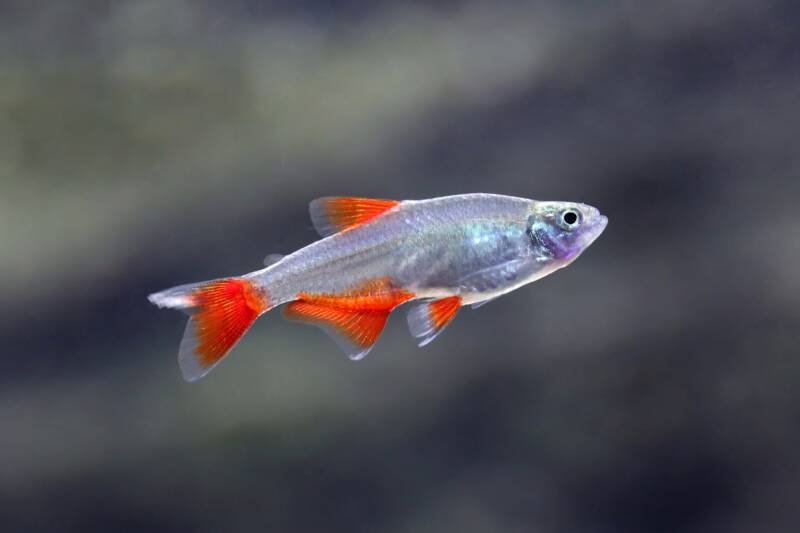
Minimum Tank Size: 20 gallons
Blood-fin tetras bring visual interest with silver bodies and contrasting bright red fins.
Their two-inch (5 cm) length is suitable to pair with your pea puffer, and a group of five to seven tetras is enough for them to be comfortable.
These peaceful, schooling fish stick to the upper half of the water column.
Water temperature and pH parameters match well between the blood-fin and puffer; however, this tetra needs exceptionally soft water.
Keep the hardness at the lower end of the puffer’s range for compatibility.
Freshwater Shrimp
Pairing your pea puffer with shrimp is hit or miss.
Puffers are opportunistic feeders, eating whatever fits in their mouths. Successful cohabitation may depend on the following:
- Introducing larger, fully grown shrimp to the tank.
- Adding dither fish to provide a sense of calm and act as a distraction.
- Including plenty of hiding spaces and keeping the water conditions stable.
Consider the following shrimp with caution.
10. Amano Shrimp (Caridina multidentate)

Minimum Tank Size: 10 gallons
Amanos reach a larger adult size near two inches (5 cm).
They have transparent bodies with rows of dark dots along their sides.
Amano shrimp are highly efficient at camouflage and incredibly meticulous in algae consumption compared to other shrimp species.
Keep them in groups of at least six similarly sized shrimp to limit hierarchical aggression.
11. Ghost Shrimp (Palaemonetes paludosus)

Minimum Tank Size: 5 gallons
Ghost shrimp are popular both as feeders and for their tank cleaning capabilities.
These transparent scavengers devour algae and detritus.
Keep the water parameters stable and the pH close to neutral. They reach about an inch and a half (3.8 cm) fully grown.
Start with a group of 20 or so for the best odds of success.
12. Cherry Shrimp (Neocaridina heteropoda)

Minimum Tank Size: 5 gallons
Cherry shrimp stay small at an adult size of 1.5 inches (3.8 cm) and come in color grades from bright red all over to transparent with red spots.
They are active scavengers that display their best colors when comfortable in their environment.
Start with a group of at least 10 to minimize dominance squabbles.
Closing Thoughts
Your tiny pea puffer can pair with multiple species to create a fun, colorful, and active tank.
The best pairings are fish that occupy other levels of the tank, schooling fish, and fast swimmers.
Stable water conditions, an appropriate diet, and a well-laid-out tank can help keep things peaceful.
What are your favorite fish to pair with a pea puffer?
Let us know your thoughts!